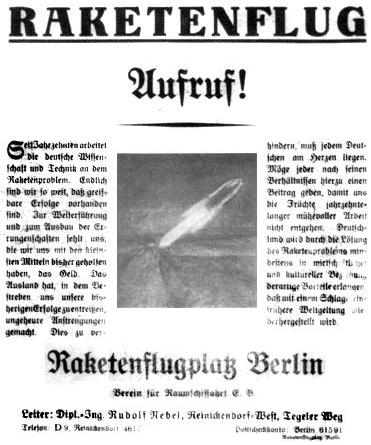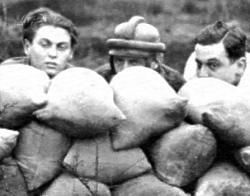
Home - Search - Browse - Alphabetic Index: 0- 1- 2- 3- 4- 5- 6- 7- 8- 9
A- B- C- D- E- F- G- H- I- J- K- L- M- N- O- P- Q- R- S- T- U- V- W- X- Y- Z
Raketenflugplatz

Raketenflugplatz
Aufruf!
Seit Jahrzehnten arbeitet die deutsche Wissenschaft and Technik and dem Raketenproblem. Endlich sind wir so weit, daß greifbare Erfolge vorhanden find. Zur Weiterführung und zu Ausbau der Errungenschaften fehlt uns die wir uns mit den kleinsten Mitteln bisher geholfen haben, das Geld. Das Ausland hat, in dem Verstreben uns unsere bisherigen Erflog zu entrissen, ungeheure Anstrengungen gemacht. Dies zu verhindern, muß jedem Deutschen am Herzen liegen. Möge jeder nach seinen Verhältnissen hierzu einen Beitrag geben, damit uns die Früchte jahrzehntelanger mühvoller Arbeit nicht entgehen. Deutschland wird durch die Lösung des Raketenprobleme mindestens in wirtschaftlicher und kultureller Beziehung derartige Vorteile erlange, daß mit einem Schlage seine frühere Weltgeltung widerhergestellt wird.
Raketenflugplatz Berling
Verein für Raumschiffahrt E V
Leiter: Dipl-Ing Rudolf Nebel, Reinickendorf-West, Tegeler Weg
Telefon: D9, Reinickendorf 4617 Postscheckkonto: Berlin 61591
Translation
Rocket flight!
Call for action!
For years the German scientific and technical communities have worked on rocket technology.. Finally we have come far enough, that success is within reach. So far this work we have funded this work ourselves, although our resources are modest. Further development now will require funding beyond our resources. Other countries have seen our progress and are poised to rip our successes from our hands. Every true German must act to prevent this. Everyone is requested to make a contribution according to their means, so that the fruits of decades of hard work are not lost. The development of rocket technology will obtain economic and cultural advantages that will ensure that it reaches its earlier place in the world.
Rocketport Berlin
Association for Space Travel
Head: Rudolf Nebel, Reinickendorf-West, Tegeler Weg
Telephone: D9, Reinickendorf 4617 -- Post office giro account: Berlin 61591
First Launch: 1931-05-10. Last Launch: 1931-08-01. Number: 6 . Location: Reinickendorf-West, Berlin. Longitude: 13.21 deg. Latitude: 52.35 deg.
Family: Suborbital Launch Site. Country: Germany. Launch Vehicles: V-2, Mirak. Agency: VfR.
 | Raketenflugplatz Credit: © Mark Wade |
1927 June 5 - . Launch Site: Raketenflugplatz. Launch Complex: Raketenflugplatz. Launch Vehicle: V-2.
- VfR established. - .
Nation: Germany.
Related Persons: Esnault-Pelterie,
Hohmann,
Oberth,
Winkler.
Johannes Winkler forms the first society for space travel in Breslau. The Society for Space Travel (Verein fuer Raumschiffahrt), is better known by its abbreviation 'VfR'. From the three people that attended the first meeting, it would grow to 500 members within the year, including most of the European space pioneers - Oberth, Hohmann, von Hoefft, von Pirquet, Rynin, and Esnault-Petrie.
1930 September 27 - . Launch Site: Raketenflugplatz. Launch Complex: Raketenflugplatz. LV Family: V-2. Launch Vehicle: Mirak.
- Raketenflugplatz Berlin - . Nation: Germany. Related Persons: Nebel. Nebel signs the $4/year lease for the worlds first 'Rocket Port', an abandoned German army munitions storage area on 10 square kilometres on Tegeler Weg in the Berlin northern suburb of Reinickendorf. The numerous bunkers are ideal for rocket motor tests..
Spring 1931 - . Launch Site: Raketenflugplatz. Launch Complex: Raketenflugplatz. LV Family: V-2. Launch Vehicle: Mirak.
- Second Mirak explodes - .
Nation: Germany.
Related Persons: Nebel.
Nebel and the other designers realise that using liquid oxygen to cool the combustion chamber simply would not work - it turned to gas, and the excessive pressure eventually burst the oxygen tank. They turn to a water-cooled combustion chamber. The end result was an aluminium pressure-fed engine that weighed 85 g but produced 32 kgf while burning 160 g of liquid oxygen and gasoline per second - a specific impulse of 200 seconds. The new design proves reliable and is demonstrated to visitors from the American Rocket Society in April 1931.
1931 May 10 - . Launch Site: Raketenflugplatz. LV Family: V-2. Launch Vehicle: Mirak.
- Mirak II / Repulsor - .
Nation: Germany.
Related Persons: Riedel, Klaus.
Apogee: 0.0020 km (0.0012 mi).
Riedel improvises a rocket, using the thrust chamber developed for the Mirak, fed by two long tanks containing liquid oxygen and gasoline, which would form guiding sticks for the forward-mounted engine. The lashed-together rocket rises to 20 m on its first 'static' test.
1931 May 14 - . Launch Site: Raketenflugplatz. LV Family: V-2. Launch Vehicle: Mirak.
- Mirak II / Repulsor I rocket reaches 60 m. - .
Nation: Germany.
Apogee: 0.0060 km (0.0037 mi).
First official test flight of the Mirak (Minimum Rakete) II. A flight-weight version of Riedel's 'flying test stand' takes off into a looping trajectory, sending the VfR experimenters running for cover, but reaching 60 m altitude in the process. Attending were Wernher Von Braun, Klaus Riedel und Kurt Heinisch (Rudolf Nebel, the chief engineer, was in Kiel at the time).
1931 May 23 - . Launch Site: Raketenflugplatz. LV Family: V-2. Launch Vehicle: Mirak.
- Mirak II / Repulsor 2 - . Nation: Germany. Related Persons: Riedel, Klaus. Apogee: 0.0060 km (0.0037 mi). Range: 0.60 km (0.37 mi). The rocket reaches 60 m before heading off horizontally over the Raketenflugplatz, ending up in a tree outside the perimeter, 600 m from the launch point..
Early June 1931 - . Launch Site: Raketenflugplatz. LV Family: V-2. Launch Vehicle: Mirak.
- Mirak II / Repulsor 3 - . Nation: Germany. Related Persons: Riedel, Klaus. Apogee: 0.18 km (0.11 mi). Range: 0.60 km (0.37 mi). This is the first Repulsor equipped with a recovery parachute. It reaches 180 m, but then the parachute deploys early, and it falls into the same clump of trees as Repulsor 2, 600 m from the launch point..
July 1931 - . Launch Site: Raketenflugplatz. LV Family: V-2. Launch Vehicle: Mirak.
- Mirak II rocket reaches height of 500 m - . Nation: Germany. Apogee: 0.50 km (0.31 mi). VfR successfully fired an improved Mirak (Minimum Rakete) II rocket to height of 500 m..
August 1931 - . Launch Site: Raketenflugplatz. LV Family: V-2. Launch Vehicle: Mirak.
- Mirak II / Repulsor 4 - .
Nation: Germany.
Related Persons: Riedel, Klaus.
Apogee: 1.00 km (0.60 mi).
The perfected Repulsor has the propellant tanks close together at the centreline, to form a guide stick in the manner of Congreve's war rockets. It reaches an altitude of 1000 m, and the parachute recovery system functioned perfectly at apogee. Subsequent such 'one stick' Repulsors' will reach 1500 m altitude and 3000 m range - in fact, they are normally launched only partially-fuelled to prevent them landing outside the perimeter of the Raketenflugplatz.
October 1931 - . Launch Site: Raketenflugplatz. Launch Complex: Raketenflugplatz. LV Family: V-2. Launch Vehicle: Mirak.
- Raketenflugplatz featured in newsreel - .
Nation: Germany.
Apogee: 1.50 km (0.90 mi). Range: 3.00 km (1.80 mi).
After one year of operation of the worlds first 'rocket port', the Ufa weekly newsreel carries an extensive film report on the VfR's experiments. By then 270 engine test runs had been completed, as well as 87 test flights of Repulsors. However the filmmakers also capture an errant rocket leaking gasoline onto a shack owned by the police, which burns down. This leads to further restrictions on VfR activities at the site.
1933 September 30 - . Launch Site: Raketenflugplatz. Launch Complex: Raketenflugplatz.
- End of Raketenflugplatz - .
Nation: Germany.
Related Persons: Nebel,
Riedel, Klaus.
Nebel is presented with a water bill of 1600 Marks for 1930-1933. He and the VfR are unable to pay, so the government cancels the lease and takes the property back. Klaus Riedel manages to arrange employment for himself and several of the VfR technicians with Siemens, which also agrees to allow them to store the Raketenflugplatz rockets and technical materials in a company warehouse. After Riedel and the others are recruited by the Army and leave for Peenemuende, Nebel allegedly sells of these materials. In any case they disappear.
Back to top of page
Home - Search - Browse - Alphabetic Index: 0- 1- 2- 3- 4- 5- 6- 7- 8- 9
A- B- C- D- E- F- G- H- I- J- K- L- M- N- O- P- Q- R- S- T- U- V- W- X- Y- Z
© 1997-2019 Mark Wade - Contact
© / Conditions for Use